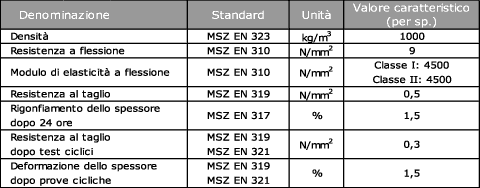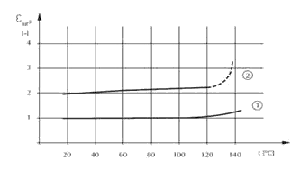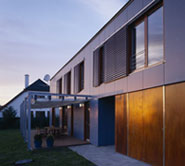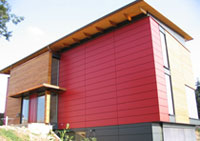Mechanical Characteristics
The panels in cement bonded are realized in conglomerate cementizio "Portland" (the only concrete that does not contain Radon) and Wood Fibers of Pine to 100% press. The quality, is guaranteed by the greater institutes of certification of European qualities.
General Strenght Properties of Cement Bonded Particle Boards

As a guide to the design of building structures to limit stress, the specifications of MSZ 15025/1989 should be applied. When designing building structures, the following permitted stress should be taken into account on the basis of data supplied by "Institut fur Bautechnik, Berlin"
- Permitted bending strenght for loading perpendicular to plane of board: 1,8 N/mm²
- Permitted tensile strenght in plane of board: 0,8N/mm²
- Permitted compression strenght in plane of board: 2,5N/mm²
- Modulus of elasticity in bending for calculation purposes: 2000N/mm²
Buckling Strenght of Cement Bonded Particle Boards
Specimens of uniform cross-section, but different lenght were used for tests. In the case of Betonyp boards, buckling applies usually to large boards rather than rods. The buckling strenght of board can be determined by quite simple calculation with sufficient accuracy.
Behaviour Of The Cement Bonded Chipboards Under The Influence Of Thermal Load

As an excellently suitable means for characterizing structural materials, the thermomechanical curve can be obtained by plotting deformation as a function of temperature.
The tests indicate that:
The thermomechanical curve can be regarded as linear up to 120°C temperature;
The straight section corresponding to higher nominal stress is steeper due to the more significant effect of temp on the nonlinear part of deflection diagram;
For higher nominal stress, from 100°C temp, an increasing number of test specimens did not pass the load test, at a temp of 140°C all specimens failed under load;
From 120°C temp (for both stress levels) a sudden increase in specific deformation accurs. It follows that the upper limit of thermal load for Betonyp boards is 120°C.
The Effect Of Moisture Content On Strenght Values
The various strenght values of cement-bonded chipboard are interrelated with the moisture content prevalling at a given time.
It can be stated that the compression strenght and bending strenght decrease considerably due to an increase in moisture content. The tensile, shear and impact-breaking strenght slightly change under the influence of moisture content. The impact-breaking strenght, unlike other strenght properties, improves slightly due to an increase in moisture content. Obviously, it results from the fact that the hollows are filled up with incompressible water to an increasing degree.
Creep of Cement Bonded Particle Boards due to bending stress

For load-bearing structures designed for longer life, the change of individual properties in time plays a significant role. As a result of the macromolecular composition of wood, certain mechanical properties undergo changes even if load and physical properties remain unchanged which should be considered, when designing building structures. The science of rehology deals with the stresses and deformations caused by loading as a function of time. The test has proved that the initial elastic deformations are much more favourable for the cement- bonded chipboards than for the traditional chipboards. It is mainly due to the higher flexural rigidity. The initial elastic deflection for the Cement Bonded Particle Boards is only about 1/5 of the values obtained for furniture-grade chipboards. The degree of creep can be characterized clearly by the multiplication factor a, which depens on the load time and when multiplied by Yo yields the actual deformation corresponding to load time t. Although the values a for cement-bonded chipboards are usually 2-4 times higher than those obtained for standard chipboards, if the load time exceeds 1 year, the actual deformations will be significantly lower.
Fungus And Insect Resistance of Cement Bonded Particle Boards
The test of Cement Bonded Particle Boards for their fungus resistance were conducted in 1976 by the Department of Forest Protection Methods in the University for Forestry and Wood Industry.
The tests of baords for their mould resistance have been carried out in conformity with the specifications of Standard MSZ 8888/9-69. The tests have proved that the Cement Bonded Particle Boards are "fungicides". The tests for resistance against wood rotting fungi has been conducted in conformity with the specifications of Standard MEMSZ 50 373. The cultures of Coniophora cerebella, Poria vaporaria and Trametes versicolor, that is, fungi most damaging to building structures, have been used in the trials: None of the fungus species damaged the Cement Bonded Particle Boards, thus, it has been proved that the cement-bonded chipboard is "fungus resistant". This finding has been confirmed by the test report made by Mutsui Lumber Company, Tokyo.
It has been proved by tests carried out at various European institutes that the termites do not attack the Betonyp building board even in the starvation phase. BAM, Bundesanstalt fur Materialprufung, Berlin, test report N° 5.1, \4403,1985\
The insect resistance of Cement Bonded Particle Boards has been confirmed also by the test conducted at the University of Tokyo, Faculty of Agriculture.
Weather Resistance of Cement Bonded Particle Boards

The Cement Bonded Particle Boards are weather resistant, since the wood chip particles are protected by the set cement against external damaging effects. The material of formworks completely or partially dug in the earth did not show damage during test carried out for many years. The headquarters of the Betonyp was built with socle partly made of lost cement-bonded chipboard shuttering. The nearly twenty-year-old structures have not undergone any changes. The test series conducted in this subject by the Woodworking Research Institute also confirmed these results. The cement-bonded chipbaord has been tested by EMPA/Switzerland, 1975 in a series of measurements consisting of 150 cycles at temperature of - 20oC and +20oC and at varying moisture content. These tests qualified the board as definitely frost- resistant. It follows that the Betonyp building board without finishing will withstand weathering and extreme stresses.